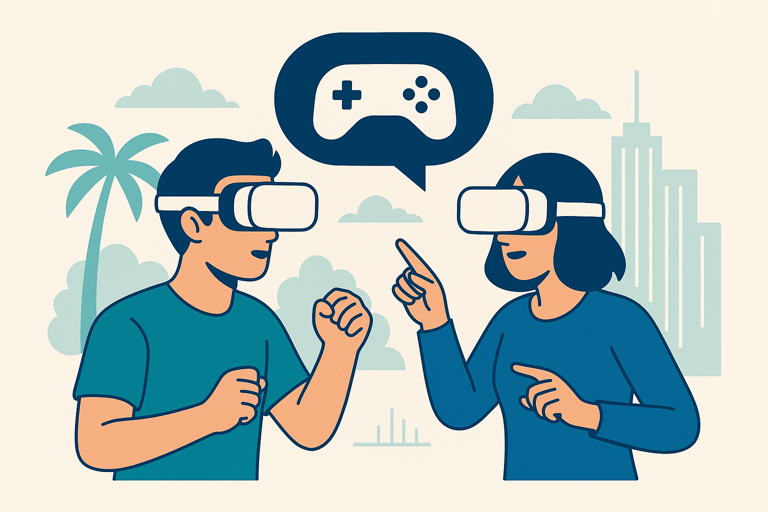
Virtual Reality and Online Games: Is VR the Future of Multiplayer Experiences?
Introduction
Virtual Reality (VR) is no longer just a futuristic idea from science fiction. Over the last few years, it has rapidly evolved and made its way into homes, workplaces, and — most notably — online gaming. The idea of stepping directly into a game world, moving through it in full 3D, and interacting with others face-to-face in virtual spaces is both exciting and groundbreaking.
But can VR truly become the future of multiplayer experiences? Let’s explore how VR is changing online games, what it offers, and what challenges still lie ahead.
What Makes VR Gaming Unique?
VR allows players to physically move, look around, and interact with virtual environments using motion controllers and headsets. Unlike traditional gaming, where you sit with a keyboard, mouse, or controller, VR puts you “inside” the game.
Multiplayer VR takes this to the next level — letting you meet and communicate with other players as if you’re in the same room. You can gesture, look people in the eyes (or at least their avatars), and experience a level of presence that 2D screens just can’t offer.
What VR Adds to Online Games
1. Greater Immersion
When playing in VR, the screen surrounds you. This makes everything feel more real — whether you’re exploring a fantasy world, piloting a spaceship, or playing table tennis with someone across the globe. This level of immersion makes multiplayer sessions feel personal and memorable.
2. Natural Interaction
Voice chat is common in multiplayer games, but VR adds body language and movement. You can wave, nod, or dance — all of which help express emotion and build stronger social connections. It brings online friendships closer to real-life interactions.
3. Creative Spaces
VR multiplayer isn’t limited to just combat or missions. It also includes social platforms where players hang out, build things, or explore together. From virtual clubs to drawing rooms to entire user-created worlds — VR creates new ways to play and connect.
4. Fitness and Movement
Unlike traditional gaming, VR can get players moving. In multiplayer rhythm games, sword fights, or sports simulations, players often break a sweat. This blend of gaming and physical activity adds a healthy bonus to the experience.
Current Popular VR Multiplayer Games
- VRChat: A social platform where players can create avatars and explore user-made worlds.
- Rec Room: A collection of mini-games and activities where people meet, compete, or just hang out.
- Population: One: A battle royale shooter with climbing, flying, and tactical teamwork — all in VR.
- Beat Saber (with online mode): A rhythm game with competitive multiplayer support.
These titles show the variety and potential of VR in multiplayer gaming — from casual hangouts to action-packed gameplay.
Challenges VR Still Faces
Even with all the exciting progress, VR isn’t yet the standard in online multiplayer. Several challenges still stand in the way:
1. Cost of Equipment
VR headsets and powerful PCs or consoles are still expensive for many players. While standalone headsets are getting cheaper, high-end VR remains a luxury for most gamers.
2. Physical Space and Comfort
Not everyone has room to move around safely in their home. Some people also experience motion sickness or discomfort during long sessions, which limits how long they can play.
3. Learning Curve
VR controls are very different from traditional gaming. For new players, it can take time to get used to movement, aiming, or interacting in 3D space. Not every gamer is ready to make the switch.
4. Limited Game Selection
While the library of VR games is growing, there are still fewer big-name titles in VR compared to regular consoles and PCs. Many popular franchises haven’t made the jump yet — though that may change in the future.
Is VR the Future of Multiplayer?
VR isn’t likely to completely replace traditional gaming anytime soon. However, it’s clearly becoming a key part of where the industry is heading. As technology becomes more affordable and developers continue to experiment with new ideas, VR will become a more common part of online play.
In the future, we may see hybrid games — playable in both VR and traditional formats — allowing players to choose how they experience the world. We might also see VR integrated into competitive eSports, virtual classrooms, or large online festivals and events.
Multiplayer VR may not yet be mainstream, but it’s gaining momentum — and the possibilities are endless.
Conclusion
Virtual Reality is reshaping how people connect and play in online games. It brings more than just flashy visuals — it offers real interaction, shared experiences, and a powerful sense of presence that’s hard to match on a flat screen.
While there are still hurdles to overcome, the future of multiplayer gaming could very well be virtual. And as VR becomes more accessible, it’s likely that more players will step into these new worlds — together.